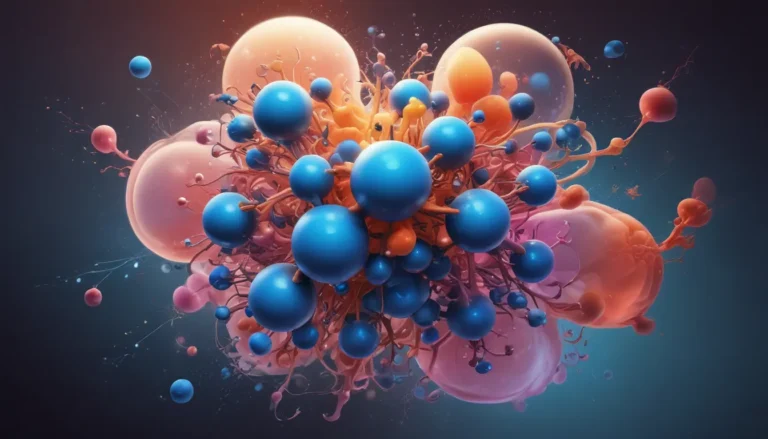A Note About Images: The images used in our articles are for illustration purposes only and may not exactly match the content. They are meant to engage readers, but the text should be relied upon for accurate information.
Are you ready to embark on a journey into the captivating realm of mass spectrometry? This powerful analytical technique has revolutionized the field of chemistry, offering scientists a window into the molecular world like never before. From unraveling the mysteries of molecular structure to exploring its diverse applications, mass spectrometry continues to amaze and inspire researchers worldwide. Join us as we uncover eight extraordinary facts that shed light on the incredible capabilities of this innovative tool.
The Molecular Detective: Unraveling Structure and Behavior
Imagine mass spectrometry as a molecular detective, solving mysteries in the world of chemistry. By measuring the mass-to-charge ratio of ions in a sample, scientists can analyze and identify the chemical composition of molecules with precision. This allows for a deeper understanding of how molecules interact and behave in different environments, shaping the foundations of scientific discovery.
A Super-Powered Microscope: Illuminating the Unseen
Mass spectrometry acts as a super-powered microscope for molecules, offering insights that transcend traditional boundaries. From medicine to environmental science and art conservation, this technique plays a pivotal role in uncovering hidden secrets. Like a superhero with the power to see the unseen, mass spectrometry reveals a world of possibilities waiting to be explored.
The Versatility of Mass Spectrometry: Broad Applications
With its broad applications, mass spectrometry finds a place in various fields, including environmental analysis, pharmaceutical research, forensic science, and proteomics. Whether detecting pollutants in water, identifying biomarkers in diseases, or studying complex biological systems, this technique serves as a beacon of scientific innovation and problem-solving prowess.
Unlocking the Origins: Isotope Ratio Analysis
One of the remarkable features of mass spectrometry is its ability to measure isotopic ratios, shedding light on the origin and history of substances. This capability has proven invaluable in studying climate change, analyzing archaeological artifacts, and even tracing the source of counterfeit products. By examining the relative abundance of isotopes, scientists can uncover a wealth of information that transcends conventional boundaries.
Precision and Accuracy: The Hallmarks of Mass Spectrometry
Mass spectrometry instruments are renowned for their high sensitivity and accuracy, capable of detecting even the smallest amounts of analytes. Whether quantifying drug metabolites or identifying pollutants in the environment, this technique delivers precise and reliable results, often at trace level concentrations. Its ability to provide accurate data underscores its importance in scientific research and analytical laboratories.
Beyond Individual Molecules: Mass Spectrometry Imaging
Mass spectrometry has evolved beyond analyzing individual molecules, embracing imaging techniques that map the spatial distribution of compounds within samples. This advancement enables researchers to study tissue sections, analyze drug distribution within organs, and even visualize the composition of paintings and artworks. By offering a new perspective on complex systems, mass spectrometry imaging broadens the horizons of scientific exploration.
Proteomics and Biomarker Discovery: Unveiling Insights
In the realm of proteomics, mass spectrometry plays a pivotal role in studying proteins and identifying potential biomarkers. By analyzing the intricate mixture of proteins in a sample, scientists gain valuable insights into disease mechanisms, drug interactions, and the development of targeted therapies. This transformative capability continues to drive advancements in the fields of biochemistry and biomedical research.
Time-of-Flight Mass Spectrometry: Rapid Analysis at Your Fingertips
Time-of-flight (TOF) mass spectrometry offers a swift and accurate method for analyzing ions based on their flight time. This technique, commonly used in high-throughput screening for drug discovery, food safety analysis, and environmental monitoring, provides valuable insights with efficiency and precision. Its rapid analytical capabilities make it an indispensable tool for modern research and analytical applications.
Mass Spectrometry in Forensic Science: Unraveling Mysteries
In the realm of forensic science, mass spectrometry serves as a powerful tool for investigating unique chemical profiles in materials such as drugs, explosives, and fibers. By linking evidence to specific sources, forensic scientists play a crucial role in criminal investigations and courtroom proceedings. The invaluable insights provided by mass spectrometry contribute to the pursuit of justice and truth in forensic science.
As we delve into the world of mass spectrometry, we uncover a tapestry of remarkable capabilities and transformative applications. From analyzing molecular structures to mapping spatial distributions, this innovative technique continues to shape modern science and inspire groundbreaking discoveries. Let’s celebrate the extraordinary facts of mass spectrometry and embrace the impact it has on advancing our understanding of the world around us.
FAQs: Unveiling Insights and Answers
-
What is mass spectrometry?
Mass spectrometry is a powerful analytical technique used to determine the masses and abundances of atoms and molecules in a sample. By ionizing sample molecules and separating them based on their mass-to-charge ratio, scientists gain valuable insights into the composition and structure of compounds. -
How does mass spectrometry work?
Mass spectrometry involves ionization, mass separation, and detection processes. Sample molecules are ionized, accelerated, and separated based on their mass-to-charge ratio in a mass analyzer. The resulting ions are detected, providing information on their abundance and composition. -
What are the applications of mass spectrometry?
Mass spectrometry finds applications in various fields, including chemistry, biochemistry, forensics, and environmental science. It is used for compound identification, quantification, molecular structure determination, and analysis of complex biomolecules. -
What are the different types of mass spectrometry?
Several types of mass spectrometry exist, such as electron impact ionization mass spectrometry (EI-MS), matrix-assisted laser desorption/ionization mass spectrometry (MALDI-MS), and electrospray ionization mass spectrometry (ESI-MS). Each type offers unique advantages and applications in analytical research. -
Is mass spectrometry a reliable technique?
Yes, mass spectrometry is a highly reliable technique known for its accurate mass measurements and specificity in compound identification and quantification. Proper calibration, sample preparation, and data analysis are essential for obtaining reliable results and ensuring the integrity of analytical findings. -
Is mass spectrometry expensive?
The cost of mass spectrometry varies depending on the complexity and type of instrument used. While high-end mass spectrometers can be costly, affordable options exist for routine applications and research purposes. The benefits of mass spectrometry often justify its investment in various scientific disciplines. -
Can mass spectrometry analyze all types of samples?
Mass spectrometry can analyze a wide range of samples, including small organic molecules, inorganic compounds, proteins, peptides, lipids, and complex mixtures. Sample preparation methods may vary depending on the nature of the sample, but mass spectrometry offers versatile capabilities for diverse analytical challenges. -
Are there any limitations to mass spectrometry?
Despite its power and versatility, mass spectrometry does have limitations. Certain compounds may be challenging to ionize, and sample matrices can interfere with analysis results. Interpretation of mass spectra requires expertise and may benefit from complementary analytical techniques for comprehensive insights.
As we conclude our exploration of mass spectrometry, we reflect on its transformative impact on scientific research and analytical methodologies. The remarkable capabilities of this technique continue to shape our understanding of the molecular world and drive innovation in various fields. From uncovering structural insights to unraveling complex mysteries, mass spectrometry remains a beacon of discovery and knowledge in the realm of modern science. Let’s celebrate the wonders of mass spectrometry and continue our journey of exploration and discovery in the ever-evolving landscape of scientific inquiry.






